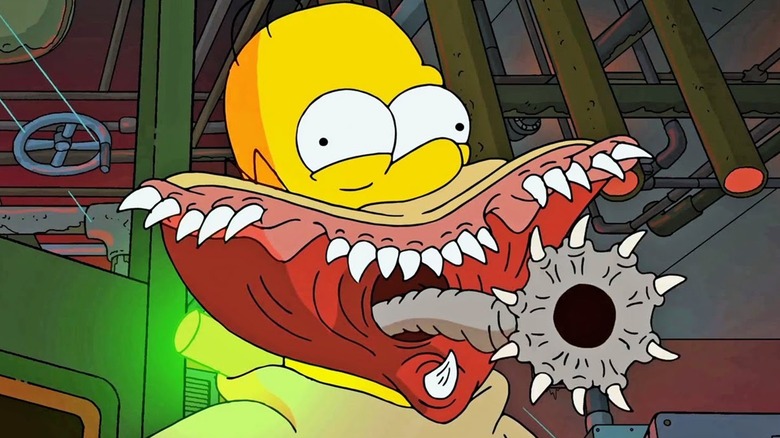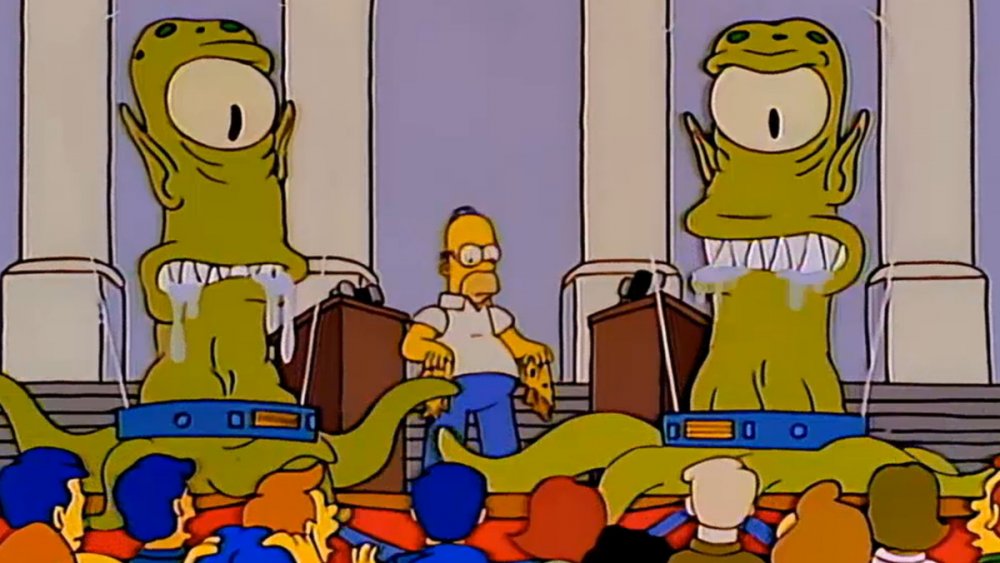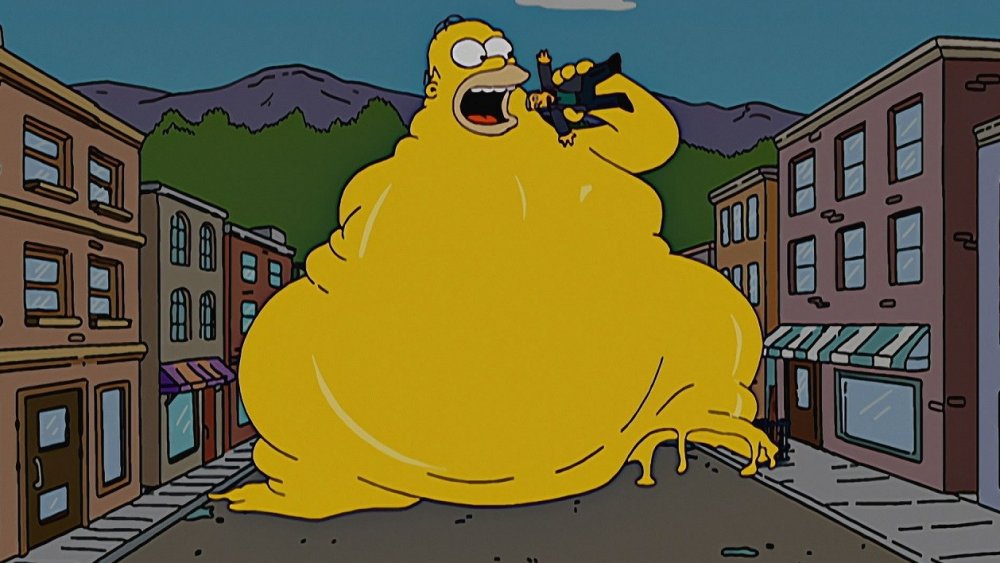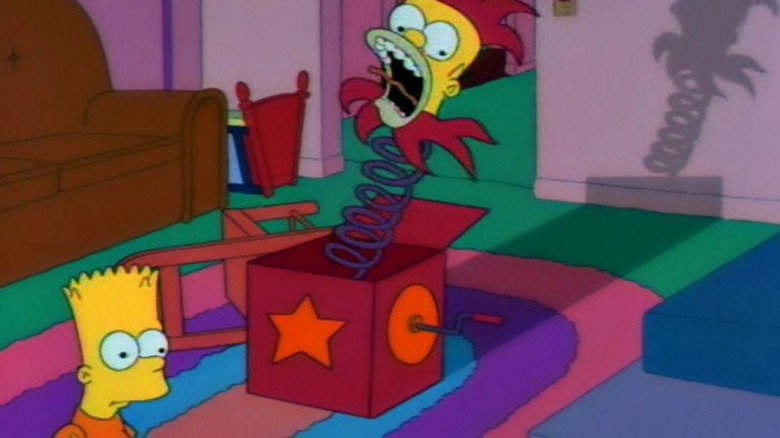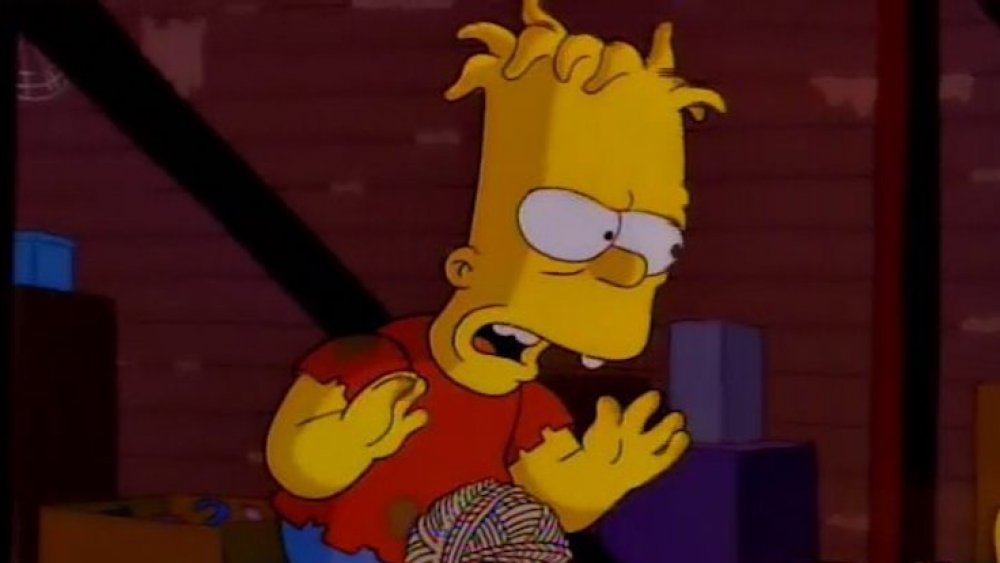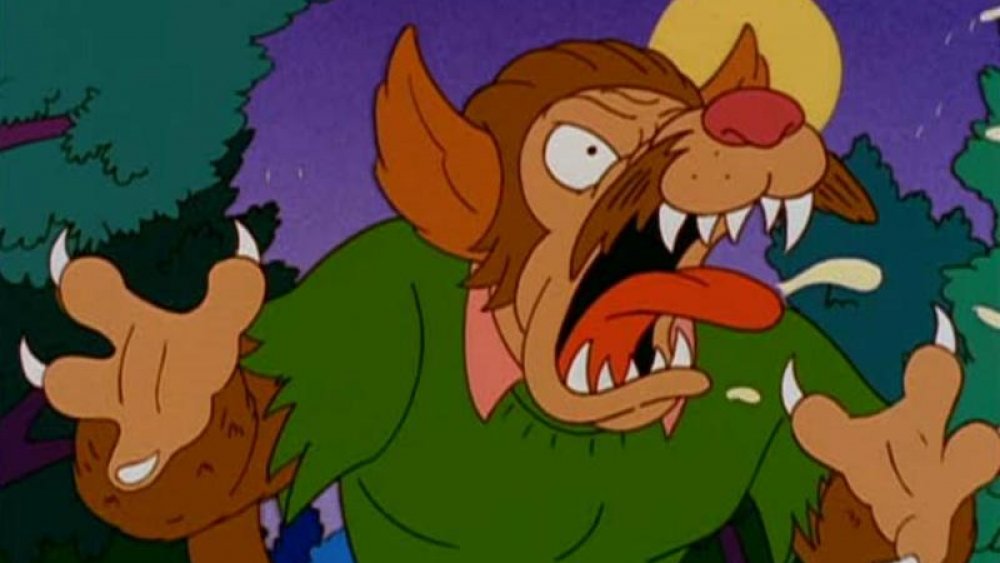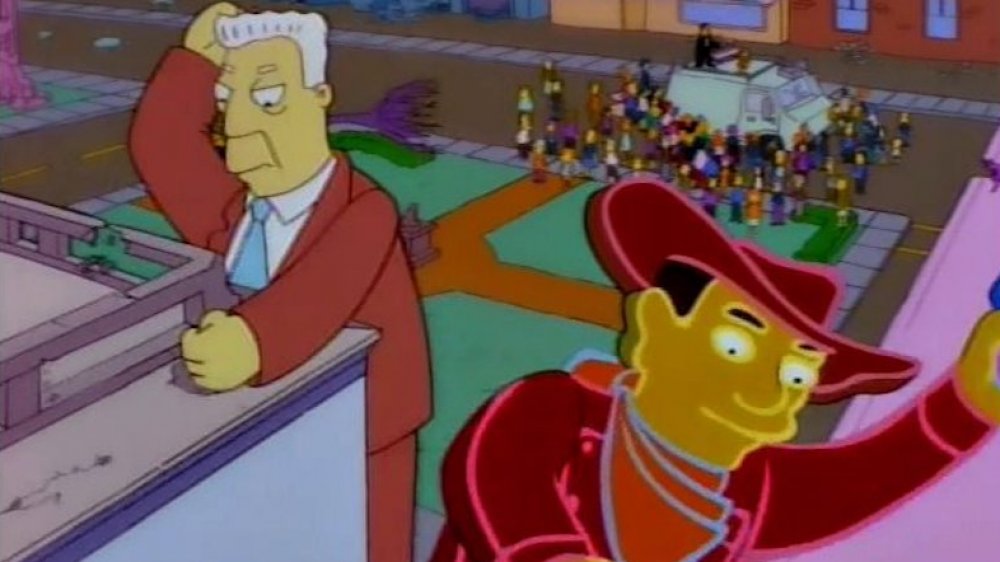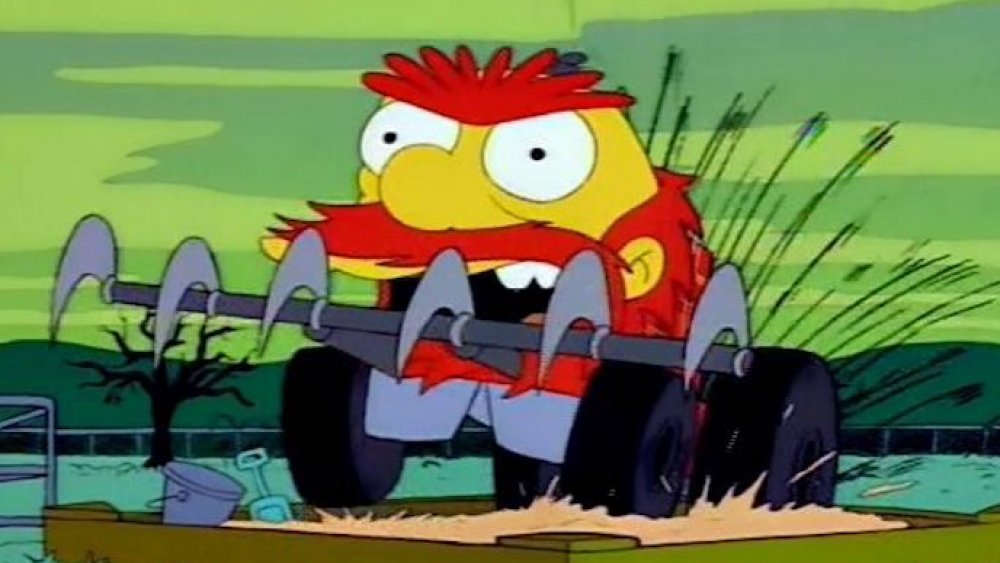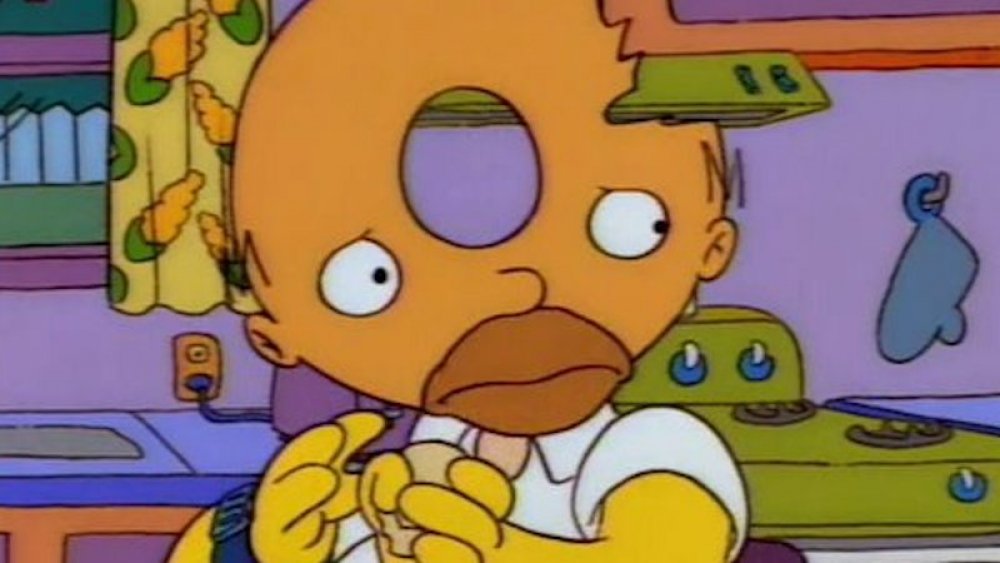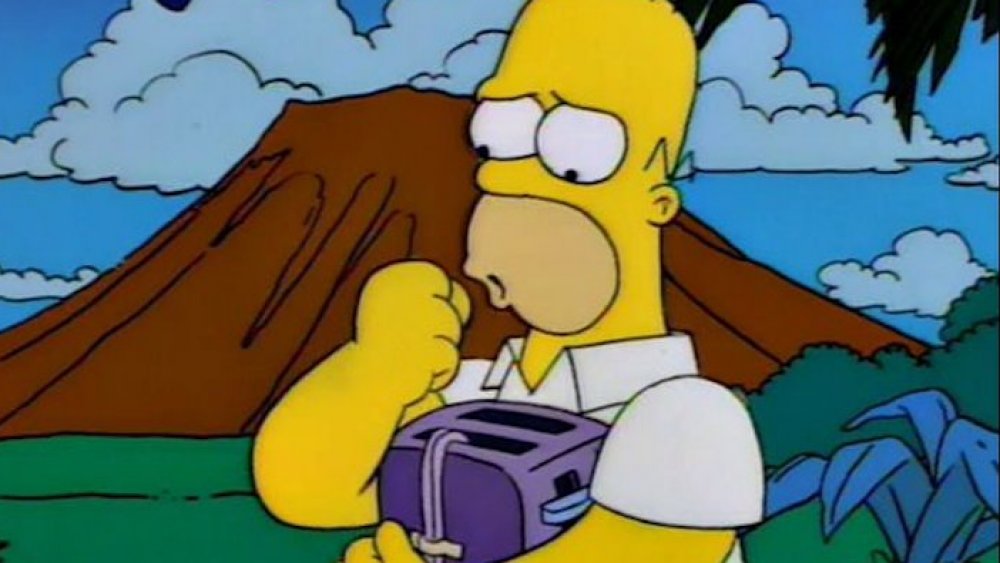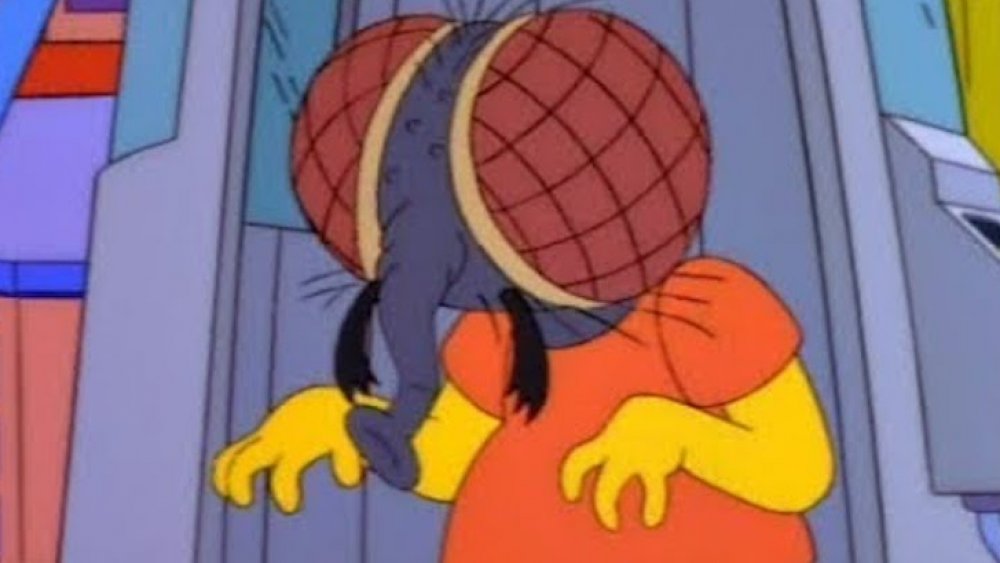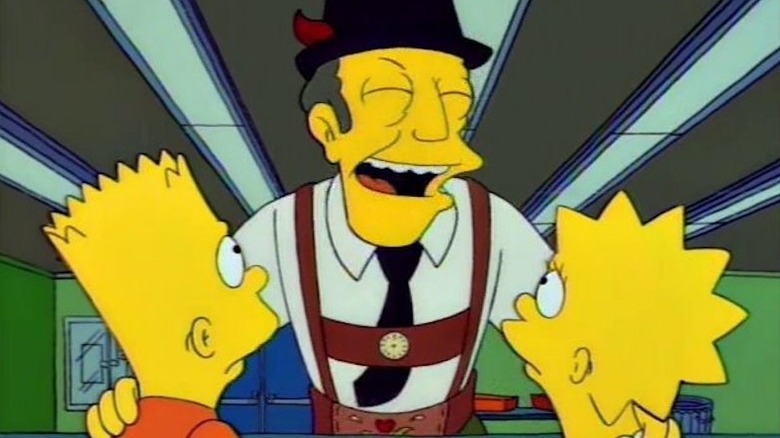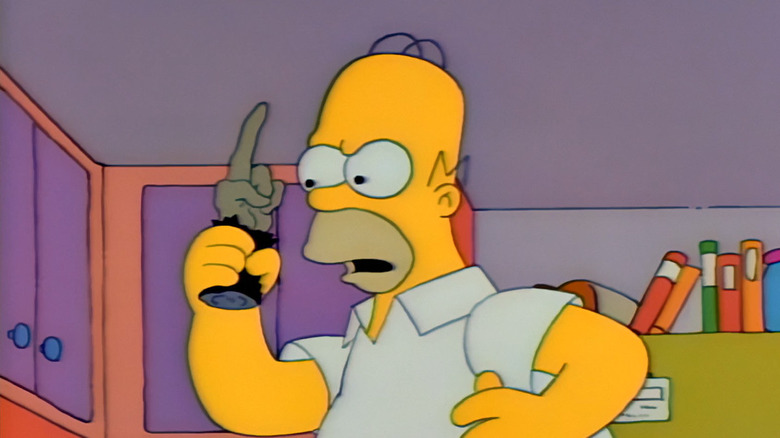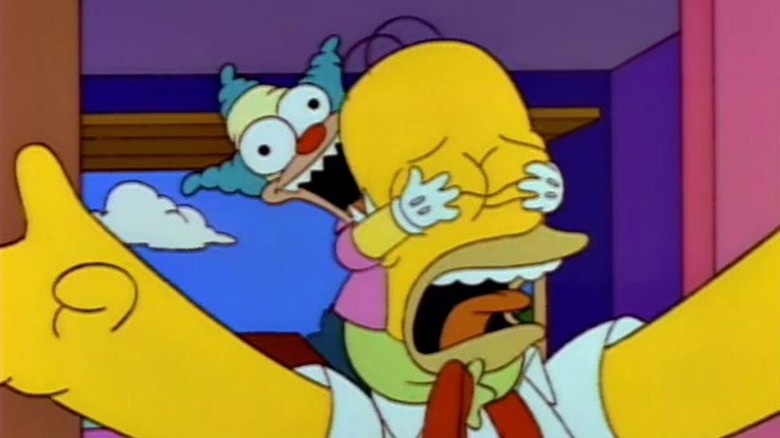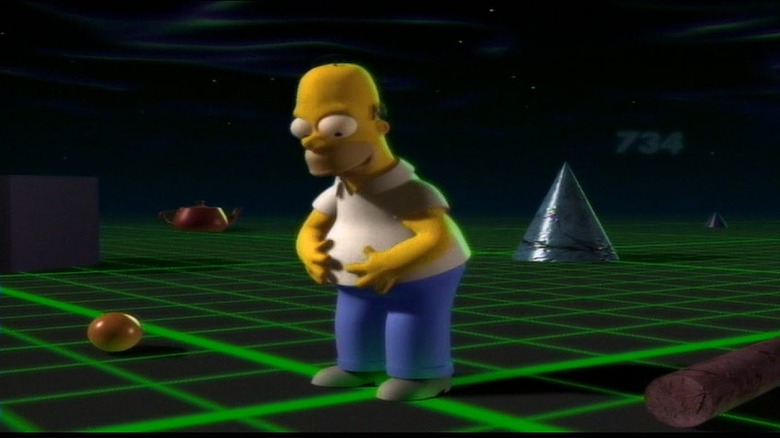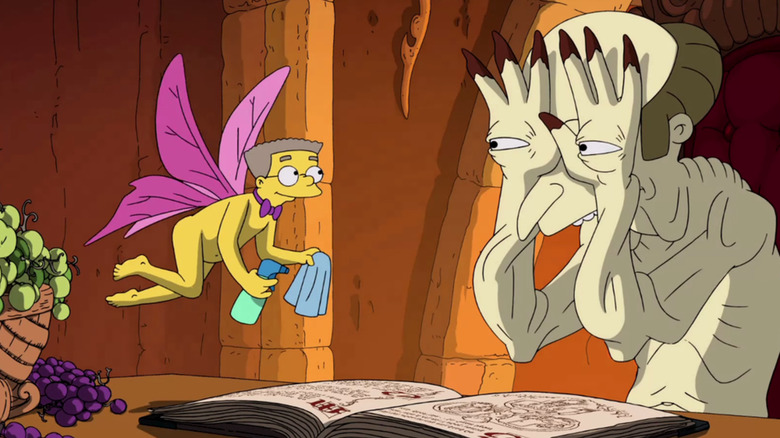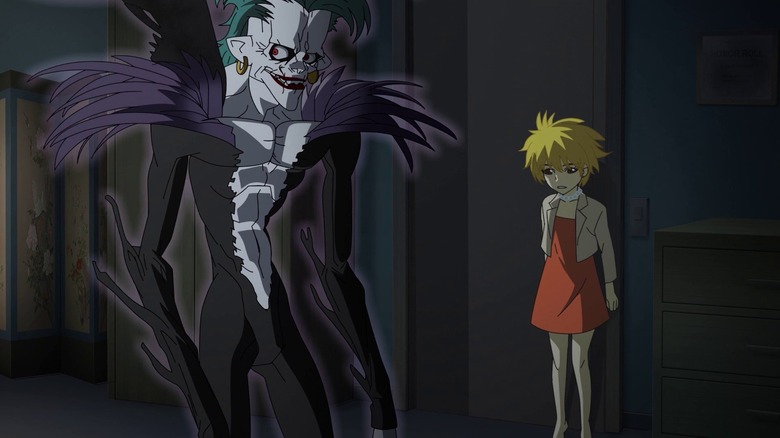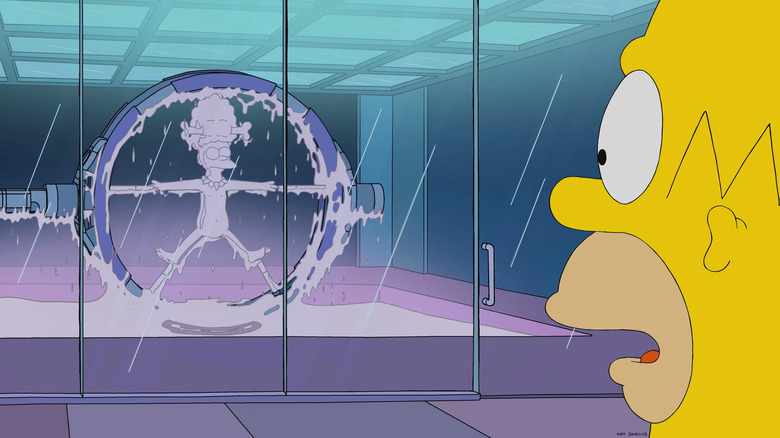The Best Simpsons Treehouse Of Horror Episodes
For decades, most TV comedies had an annual Christmas episode, in which all the characters learn the true meaning of the holiday and probably also meet Santa. "The Simpsons" helped open things up for television to celebrate another holiday, arguably one with just as much atmosphere and ritual involved — Halloween. Since its second season in 1990, the bitingly and uproariously funny animated series has unleashed its annual "Treehouse of Horror" spooktacular, a non-canonical anthology of three tales of frights, ghosts, and unsettling weirdness.
What makes a great "Treehouse of Horror" cartoon? They've got to be just as funny as a normal "Simpsons" episode, a little bit frightening (but not too frightening), and making fun of a famous horror movie or story doesn't hurt. There's been over 30 "Treehouse of Horror" episodes produced and aired at this point, and some of them rank right up there with the best ever episodes of "The Simpsons." Read on to experience the very best "Treehouse of Horror" installments ... if you dare.
Citizen Kang takes aim at presidential politics
"Citizen Kang" is something of a time capsule now, one that dates this episode of "The Simpsons" to a very specific time — October 1996.
Poking fun at the U.S. presidential election set for the first week of November, the "Treehouse of Horror" segment from Season 8 finds aliens Kang and Kodos attempting to take over earth by kidnapping the bodies of candidates Bill Clinton and Bob Dole, inhabiting them, and then campaigning for the presidency. The voting populace doesn't seem to notice or care that their candidates are suddenly acting strangely, such as walking down the street holding hands so as to exchange "long protein strings" or promising to move "forward, not backward, upward, not forward, and always twirling, twirling, twirling towards freedom."
It's Homer who discovers the sinister alien plot (although they spray him with booze so people will attribute his claims to that of a rambling drunk), but it ultimately doesn't matter. Even after Clinton and Dole are exposed as Kang and Kodos, the American people have no choice but to vote for one of them because of the two-party system. (Spoiler alert: Kang wins.)
Married to the Blob proves that Homer Simpson is the ultimate glutton
Homer Simpsons is a proud glutton — he once ate 64 slices of American cheese in a row, and he almost killed himself consuming a rotten six-foot party sub — and the 2006 segment "Married to the Blob" takes Homer's troubling inability to control his appetite to an absurd, horrific end. A meteorite crash-lands in Homer's yard, revealing a marshmallow-like goo inside. It's obviously of extra-terrestrial origin, what with it coming from outer space and how it keeps trying to escape Homer's attempts to eat it. But Homer does get it into his maw, and it turns him into a blob with an insatiable appetite and mad desire to eat everything in sight.
After devouring all the food in the house, he swallows the cat, a squeaky-voiced teenager, and then all of the overweight people he can find, turning himself into a towering, green, gelatinous blob. Not even TV's Dr. Phil can stop Homer's rampage (mainly because Homer eats him). Finally, Springfield's mayor comes up with a ghoulish compromise so that Homer will stop terrorizing Springfield. Quimby opens a homeless shelter, into which the tired and hungry enter ... and it leads directly into Homer's mouth.
Bart's Nightmare parodies a classic Twilight Zone episode
The uniting moral of "Treehouse of Horror II" is basically don't eat too much Halloween candy, or bad dreams will follow. Naturally, Bart goes overboard and so follows "Bart's Nightmare." It parodies "It's a Good Life," one of the most famous episodes of "The Twilight Zone" (and re-created in 1982's "The Twilight Zone: The Movie," which included in its cast Nancy Cartwright ... the voice of Bart).
The proud underachiever dreams that he can both read minds and manipulate reality with a thought. As a result, all of Springfield fears even having a negative thought about Bart, lest he deliver repercussions. He uses his powers to fulfill even his most mundane wishes. For example, when Homer refuses to turn off a football game for "The Krusty the Clown Show," Bart makes Homer the game ball, and he flies into a goal post. An angry Homer then tries to smash Bart with a chair, only for the boy to mentally transform him into a jack-in-the-box. Marge tires of the fighting and sends the two to family therapist Dr. Marvin Monroe, who tells Bart and Homer to spend more time together, leading to a hilariously out-of-place-for-a-Halloween-episode montage of wholesome activities like fishing, baseball, and church. The fatherly attention from Homer — which he may desperately need in regular life — renders his powers less effective, and it ends with Homer kissing Bart ... which is what causes Bart to wake up in terror.
The Thing and I explores Bart's evil origin
Bart Simpson has always been a troublemaker, bordering on a criminal. In the "Treehouse of Horror" segment "The Thing and I," the writers of "The Simpsons" provided a logical reason why Bart is so bad — he's evil.
It all starts when Bart and Lisa hear spooky monster noises in the attic, and they're only more curious when Homer carts off a bucket of fish heads to feed what he calls "it." That "it" turns out to be a "he," and it escapes its shackles among the attic's many unsold copies of Be Sharps records and "Homer, I Hardly Knew Me." Finally, Marge, along with Dr. Hibbert, clues in the kids, explaining that Bart was born as part of a pair of conjoined twins, and that the other one, which they named Hugo, was pure evil (confirmed by a run-of-the-mill "soul smear" test). As Hugo was "too crazy for Boys Town, too much of a boy for Crazy Town," the only solution was to chain evil Hugo in the attic and occasionally feed him some fish heads.
That's when Hugo returns and absconds with Bart, planning to sew himself back to his twin, only for Dr. Hibbert to save the day. Well, not for Bart, as the doc realizes that Bart was the evil twin and then forces him into a life as the secret, restrained attic child and grants the weird, maladjusted Hugo his freedom.
The Simpsons goes slasher with I Know What You Diddily-Iddly-Did
"I Know What You Diddily-Iddly-Did" is a late-'90s "Treehouse of Horror" installment that parodies the teen horror movies of the day, particularly "I Know What You Did Last Summer," which concerns a group of young people who accidentally kill a guy and cover it up, only to be haunted by the dead man.
"I Know What You Diddily-Iddly-Did" opens with a misdirect, as the Simpsons drive along a twisty road on a foggy night, having already escaped vampires who'd stolen their Super Sugar Crisp (obviously). But it just so happens that they're driving down the same road where neighborino Ned Flanders is enjoying one of his famous "fog walks," and since Homer forgot to put the fog lights in, Marge doesn't see Ned and runs over him, seemingly killing him.
Bart discourages calling authorities, as the police will "never believe a Simpsons killed a Flanders by accident." Instead, Homer engages in a twisted round of "Weekend at Bernie's" re-creation, hauling around Ned's rotten corpse to stage a fake death to take the heat off of Marge. After the funeral (where Homer basically confesses), the family is haunted by a man in a raincoat with a hook, and they flee to a series of spooky horror movie locales until the mysterious stalker reveals himself. It's Ned, of course, but it turns out Marge didn't kill him after all. He was undead, having been turned into a werewolf earlier that night. The moral of the story? Avoid fog walks.
Advertising is awful in Attack of the 50-Foot Eyesores
In this segment from the sixth "Treehouse of Horror," "The Simpsons" ramps up the satire, skewering the crassness of outdoor advertising while also taking Homer to task for his gluttony. When he buys a "colossal" size donut at Lard Lad Donuts and it turns out to be the size of normal one, Homer gets so angry that he steals the giant metal donut held aloft by the store's 50-foot-tall mascot statue. Unfortunately, this act of vandalism coincides with an ionic disturbance, which jolts Lard Lad and other massive, tacky advertising characters to life. They immediately wreak havoc on Springfield — a Mr. Peanut-type cracks open a car and eats the people inside (like a peanut), Red Devil Realty's cartoon devil picks up a school bus (Otto thinks it's just an acid flashback, however), and newsman Kent Brockman gets swiped by a Kent Brockman billboard image.
The police are no help (shockingly, Chief Wiggum shoots and kills the first tall thing he sees — a high school basketball player), so Lisa consults an old advertising executive, who explains that since the mascots are commercials, the only way to stop them is by ignoring them. They further enlist the aid of '60s pop crooner Paul Anka, who writes an anti-ad jingle to convince Springfieldians to "just don't look." The tactic works, and the raging monsters fall over and die ... but not before crushing the orphanage and children's hospital.
Nightmare on Evergreen Terrace is a legit scary Simpsons episode
Most of the scary-meets-funny "Treehouse of Horror" segments lean on the comical side — a ratio of three parts funny to one part scary seems to roughly approximate the writers formula. However, every so often, one of these Halloween installments is downright scary, if not gruesome. "Nightmare on Evergreen Terrace" is both of those things (while also funny).
Bart dreams that a Freddy Krueger-esque, rake-wielding Groundskeeper Willie tries to kill him ... and he wakes up with rake wounds on his chest. He learns that Lisa and Nelson were similarly attacked with maintenance equipment in their dreams, while poor Martin is choked to death by Willie's giant tongue during a desk nap about Latin conjugation. Marge finally clues in the kids that Willie is indeed trying to kill the children of Springfield Elementary in their dreams as revenge for the parents who callously looked on when he burned to death in a furnace mishap during a budget meeting held on "the 13th hour of the 13th day of the 13th month." (Homer shouldn't have touched the thermostat, but that "lousy Smarch weather" was chilly).
That's when Bart heads into his dreams to force Willie into a fight to the death, leading to a terrifying scene featuring eerie green skies, spooky music, and Willie taking the forms of both a monster tractor and a bagpipe-style mechanical spider monster. It's frequently unsung hero Maggie who saves the day, plugging Willie's bagpipe/exhaust pipe with her pacifier.
The Devil and Homer Simpson puts a twist on a classic tale
The story of selling one's soul to the devil in exchange for worldly abundance is an old one, dating back at least to the German legend of Faust and exemplified in the classic short story "The Devil and Daniel Webster," where a satanic bargainer demands a trial to get out of his cursed contract. And yeah, this is what "The Devil and Homer Simpson" is about. Homer is so desperate for a donut that he offers to sell his soul for one. Immediately, Satan appears, and in a big twist, it's the ultra-pious Ned Flanders. Homer signs the deal, stipulating that Satan gets his soul the moment he finishes the donut. Homer doesn't hold out for long, eating the last remaining chunk during a midnight fridge raid.
Following a day in hell — where he's subject to the ironic torture of being force-fed donuts, which he enjoys — Homer's trial, at Lisa's behest, convenes. In the end, it's Devil Flanders who gets the ironic punishment, as Homer's gluttony saves his soul. See, on the back of his wedding photo, taken in a hospital because he ate his entire wedding cake before the wedding, there's a love note he wrote to Marge, in which he already pledged his undying soul to her. As a result, Homer doesn't go to hell, but he does wind up with his own head turned into a donut, which he has a tough time not eating.
Time and Punishment plays with some scary time travel tropes
As any time travel movie demonstrates, changing something that happened in the past can make for alarming changes in the present. And Homer, after somehow turning a broken toaster into a time machine, learns that lesson over and over in "Time and Punishment." After zapping himself to dinosaur times, he remembers the advice his father gave him on his wedding day: "If you ever travel back in time, don't step on anything." Of course, seconds later, an insect annoys Homer, and he squishes it.
With the butterfly effect in motion, Homer returns to the present, where Ned Flanders rules his "slaverinos" as a fascist dictator. Homer manages to escape a "re-Neducation" facility and toasts himself back to dinosaur times, insistent on righting his wrong. But he only makes things worse, squishing the first fish to crawl up on the ground, a crucial point in evolution. That makes the present a land of giants. Another trip back results in Homer sneezing on a dinosaur, felling all of the giant lizards like they were dominoes. A number of tries later — a rich Simpsons reality, underwater world, and "Flintstones" world — Homer settles on one where everything is back to normal ... except for his family's lizard tongues.
Fly vs. Fly shows that being lazy isn't worth it
While many "Treehouse of Horror" segments focus on the deadly sin of gluttony, "Fly vs. Fly" concerns sloth. In this installment, Homer buys two walk-in matter transporters at Professor Frink's garage sale and uses them to be lazier than ever. He places the transporters at the top and bottom of stairs to avoid five seconds of exercise, and then he moves one by the couch and the other in front of the fridge. He doesn't have to get up to get a beer that way.
Unfortunately, Bart sneaks downstairs in the middle of the night to experiment with the machines, and Snowball II and Santa's Little Helper head into one device, emerging as a two-headed cat-dog and a two-bottomed monster, respectively. When Bart sees a fly enter the transporter, he for some reason fantasizes that if he goes in with the fly, he'll transform into a muscular, fly-boy hybrid superhero named Superfly. Instead, it renders Bart's head on a tiny fly's body and a giant fly's head on Bart's human body. Fly-headed Bart loves his new life of feasting on sugar and syrup and tries to kill both fly-body Bart and Lisa. Finally, monster Bart eats little Bart and gets shoved into a transporter, restoring Bart to his regular state. But he's not out of danger yet, as Homer threatens to kill him with an ax because he dared touch the transporter without his dad's consent.
Nightmare Cafeteria is an especially gruesome Treehouse of Horror episode
Springfield Elementary is a woefully underfunded and poorly run school, to the point in "Nightmare Cafeteria" where both the detention room is overpacked and Lunchlady Doris has resorted to using "Grade F" meat. Principal Skinner comes up with a monstrous solution that solves both problems — kill, serve, and eat the misbehaving children. The teachers are nothing but amused when they taste their first round of "Sloppy Jimbos." German exchange student Uter likes them too, but Skinner finds an arbitrary reason to send him to detention, simply because the kid looks so tasty. Sure enough, the next day, the school is eating "Uterbraten," and Skinner accidentally admits the whole cannibalism gambit to Bart and Lisa.
What's maybe even more horrifying is that Marge refuses to help the kids, utilizing this as a teaching moment to encourage them to stand up for themselves and refuse to be eaten. But it's of no use. Lunchlady Doris and Skinner (eager to eat Bart's shorts, a nod to the character's early seasons catchphrase) back the Simpson kids and Milhouse into a "Hamilton Beech Student Chopper," where they experience some surprisingly grisly deaths. Fortunately, it was all just Bart's nightmare. Unfortunately, in the waking world, there's a fog going around that turns people inside out. And so this "Treehouse of Horror" episode ends with the skin-less Simpson family performing a musical number that's also a parody of "One" from "A Chorus Line."
Lisa's Nightmare Simpsonizes a classic horror tale
In the early years of "The Simpsons," the "Treehouse of Horror" episodes drew as much from classic horror literature as they did from popular movies and "Twilight Zone" episodes. The first "Treehouse of Horror" episode in Season 2 involved a direct dramatization of Edgar Allen Poe's "The Raven" — respectable, but kind of boring. Season 3's "Treehouse of Horror II" got a lot more creative with its "Lisa's Nightmare" segment, a Simpsonized take on W.W. Jacobs' 1902 short story "The Monkey's Paw."
Like the characters in that short story and its numerous adaptations, the Simpsons acquire a monkey's paw that grants wishes... at a terrible cost. When Bart wishes to become rich and famous, the show gets to make fun of its own merchandising. When Lisa wishes for world peace, Kang and Kodos (now in the villainous form they'll be in for the rest of the series) use the opportunity to enslave humanity. The ending, with Ned Flanders getting the paw and seemingly getting off punishment-free, is probably more nightmarish from Homer's perspective than Lisa's (who's the one having this nightmare), but that's a minor quibble with a great segment.
Clown Without Pity comes with a free frogurt
"Clown Without Pity" from Season 4's "Treehouse of Horror III" would make this list on the basis of just one moment alone: Homer's conversation with the shopkeeper at the House of Evil. Looking for a birthday present for Bart, Homer purchases a Krusty doll with a curse on it. It comes with a free frozen yogurt — which is also cursed. The back-and-forth between the pair is hilarious, and the rest of the episode is a lot of fun, too.
The cursed Krusty doll's attempts to kill Homer make for some great slapstick moments. The hapless patriarch is the main target, with the rest of the family unaware of the doll's evil nature until it's almost too late. Marge is stuck on hold with customer service ("1-900-DON'T-SUE") when she finally sees what's happening and tries to help. The ultimate solution to the problem: They need to flick the doll's "Good-Evil" switch to "Good." It's a classic "Simpsons" gag that's so stupid it's brilliant.
Homer³ entered the third dimension before Toy Story
Season 7's "Treehouse of Horror VI" aired a month before the original "Toy Story" came to cineplexes. As such, the "Homer³" segment, in which Homer enters the third dimension via computer animation, was a novelty when it aired. It also meant that the main point of reference for this style of 3D animation was "Tron," resulting in Homer's attempt to explain his new dimension by bringing up a movie that, as it turns out, no one in Springfield has actually seen. Homer getting sucked into the void is one of the more genuinely disturbing moments in "Treehouse of Horror" history — followed by one of the funnier endings of him being transported to the real world and excited about an "Erotic Cakes" store.
The animation for this segment was handled by Pacific Data Images, which took the job for well under market value just so it could work on Matt Groening's iconic show. "They said, 'This is how much we have,' and we said, 'That's nowhere near enough,' but we decided to do it anyway," PDI founder Carl Rosendahl told Vice. "We were never not going to do it." In the end, it was a win-win situation — "The Simpsons" got a great "Treehouse of Horror" segment, and PDI was bought out by DreamWorks. It went on to animate such films as "Shrek" and "Madagascar," but fans of "The Simpsons" will always remember the company for its contribution to this memorable episode.
Guillermo Del Toro's extended couch gag is a horror fan's dream
Lots of different guest directors have helmed couch gags for "The Simpsons," and some are better than the episodes that followed them. One of the most impressive of these collaborations is the Guillermo Del Toro-directed opening for Season 25's "Treehouse Of Horror XXIV." The Oscar-winning filmmaker went beyond doing just a "couch gag" and reworked the entire opening sequence, creating a real feast for the eyes. Del Toro's own films, including "Hellboy," "Pacific Rim," "Blade II," and "Pan's Labyrinth," are referenced heavily throughout this opening, but the Easter eggs extend to the whole horror genre, as well as the history of "The Simpsons."
There are multiple references to past "Treehouse of Horror" episodes throughout Del Toro's opening. The one that stands out the most is the nod to 1995's "Treehouse of Horror VI," in which a giant Lard Lad statue comes to life after Homer steals its oversized donut. There's even a blink-and-you'll-miss-it reference to the "Simpsons" shorts of the late 1980s that predated the show. And, with Bart skateboarding past authors like Edgar Allen Poe and Ray Bradbury, the Universal monsters, and H. P. Lovecraft's cosmic entity Cthulhu, every frame of this opening is pure joy for fans of "The Simpsons" who also happen to be horror nerds.
The Simpsons goes anime in Death Tome
Season 34's "Treehouse of Horror XXXIII" has a segment called "Death Tome." This isn't the first time that "The Simpsons" parodied anime, or even the first time it parodied "Death Note," specifically — another such parody, titled "Murder, He Wrote," appeared in the 2008 comic "Treehouse of Horror" #14. That doesn't stop this segment from being a great homage to Tsugumi Ohba's hit manga series, heightened by excellent anime-style animation from Korean studio DR Movie, who actually worked on the "Death Note" series. "We would have botched it," animation director Rob Oliver said of the segment in an interview with Variety. "So, I'm glad they took it from us."
In contrast to "Murder, He Wrote," which cast Bart in the Light Yagami/Kira role, "Death Tome" makes Lisa the one dispensing justice through writing the names of those she believes deserve to die in the book. When she finds out that Mr. Burns is planning on causing mass flooding so he can access his yacht from closer to home, she makes him die in his sleep (unfortunately, he falls asleep right in front of a hot barbecue, and it's not a pretty end for him). When Lisa realizes she also needs to stop the board members still willing to carry out the wishes of Mr. Burns, she comes up with increasingly bizarre ends, including a toilet lion and death by embarrassment.
SimpsonsWorld is Treehouse of Horror at its best
Another outstanding segment from "Treehouse of Horror XXXIII," "SimpsonsWorld" is a parody of HBO's hit show "Westworld." Set in a theme park based around recreating classic "Simpsons" episodes, the segment satirizes the idea that some animated comedies seem almost cancelation-proof: "We're replicants in a ridiculous theme park for an ancient TV show that stopped being good after Season 45," says robo-Lisa. The segment went down well with fans and critics alike, with Bubbleblabber calling it "the highlight of the episode."
"SimpsonsWorld" is packed to the brim with classic "Simpsons" references and the comedic violence that's defined the "Treehouse of Horror" episodes over the years. The ending solidifies the segment as something special. Believing they've escaped to the real world, the family of Simpsons robots sits down in a restaurant — where they're served by Linda Belcher from "Bob's Burgers." The final shot reveals they're stuck in an interconnected series of theme parks based on various seemingly bulletproof cartoons.
